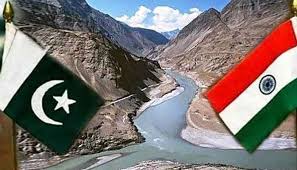Collaborative efforts are essential to protect the region’s water sources and ensure a sustainable future for the millions relying on Himalayan glacial meltwaters
By Iftikhar Gilani
The neutral expert appointed by the World Bank to examine the water dispute between India and Pakistan, specifically concerning the Kishanganga Project in Bandipora district and Pakistan’s objections to the Ratle Dam in Kishtwar district, is currently visiting Jammu and Kashmir.
Michael Leno, a French civil engineer and head of the International Commission on Large Dams, along with his technical assistant Lok Derva, arrived in Delhi on June 17 and in Jammu on June 24.
They were appointed by the World Bank in October 2022 under the Indus Water Treaty to provide an impartial assessment of these two projects.
The 330 MW Kishanganga project, located in Tehsil Gurez of Bandipora district, is operational and managed by India’s public sector National Hydro Power Corporation (NHPC).
The 850 MW Ratle project in Kishtwar is still under construction. Taj Mohiuddin, a former minister of Jammu and Kashmir had once compared the NHPC, to the British East India Company, stating that it exploits Jammu and Kashmir’s water resources to generate cheap electricity and then sells it back at high prices.
The Indus Water Treaty, brokered by the World Bank in the 1960s, governs the construction of major irrigation and power projects on the three rivers in Jammu and Kashmir.
A permanent Indus Commission facilitates communication between India and Pakistan regarding project details and disputes. If disputes remain unresolved at the Commission level, they are then referred to the water secretaries’ level. If they continue to remain unresolved, they are referred to the World Bank, which appoints a neutral expert to look at technical aspects or a Court of Arbitration, if legal issues are involved.
Most major power projects in Jammu and Kashmir have faced this dispute resolution mechanism.
For example, India had to modify the design of the Baglihar Power Project in the Doda district after the intervention of a World Bank-appointed neutral expert.
Similar issues arose with the Kishanganga project, where Pakistan, dissatisfied with the design changes, initially requested a neutral expert but later sought arbitration.
Consequently, a five-member arbitration court, chaired by Professor Sean D. Murphy, was established in The Hague.
India objected, arguing that only one mechanism could not function at a time, but the court ruled that it could address legal issues while the neutral expert handles technical aspects.
India has since boycotted the arbitration court, awaiting the neutral expert’s decision before proceeding further.
India maintains that the designs of the Kishanganga and Ratle projects comply with the Indus Water Treaty. The Kishanganga project design allows for the storage of 7.46 million cubic meters of water, essential for power generation. Similarly, India argues that the 2-meter freeboard in the Ratle project’s design meets treaty provisions and does not artificially raise water levels.
The Indus Water Treaty hailed as a major diplomatic achievement, has faced few significant disagreements.
Experts highlight the need for creative design solutions to avoid recurring problems. Pakistan asserts that western rivers’ water must not be stopped, necessitating upper-level spillways in dams.
In the Baglihar case, the neutral expert ruled in India’s favour, but the arbitration court supported Pakistan’s objections. The court stipulated that future projects should not follow Baglihar’s design.
According to the Indus Water Treaty, India is entitled to use 20% of the western rivers’ water. India disputes Pakistan’s objections to dam gate positions, citing the Salal project’s high-level gates, which have led to silt accumulation. Modern technology advocates for gates near the bottom to prevent silt build-up.
But there is a large question now haunting both courtiers beyond the Indus Water Treaty. The water sources in Kashmir are increasingly drying up.
Because of water scarcity farmers in Kashmir have shifted focus from rice cultivation to horticulture, with horticultural land use increasing by 4,000%.
Environmental degradation poses a severe threat to the region. Indus line glaciers holding up on the mountains of Kashmir, essential for Pakistan’s water supply, are melting rapidly. The Kolahoi Glacier in Kashmir has receded by 22 meters over two decades, with several smaller glaciers disappearing.
Pakistan’s Indus River, originating in Tibet and flowing through Ladakh and its tributaries like Jhelum, and Chenab rely heavily on these glaciers. The Indus basin supports three-quarters of Pakistan’s population and irrigates 80% of its cropland.
A UN study has predicted significant declines in Indus basin inflows due to global warming, warning of increased flooding, dam safety concerns, and reduced river flows. The current glacial melt trends suggest the Indus and other rivers may become seasonal, with severe economic implications.
Reports indicate a substantial glacial reduction in the Chenab basin, with some glaciers vanishing entirely. In the Sindh valley, several glaciers have disappeared or significantly shrunk, impacting water availability for agriculture.
The receding snow line, previously at 3,200 meters, has shifted to higher altitudes. Major glaciers in the Great Himalayan range have receded by 4,000-5,000 meters over the last 50 years.
Deforestation exacerbates the issue, with dense forest cover in Kashmir shrinking from 37% to 11%. Wullar Lake, a vital water reservoir, has also diminished significantly.
Environmental degradation poses a security threat beyond military conflict.
Diplomatic efforts between India and Pakistan must prioritize environmental cooperation. Expanding the mandate of the SAARC to include environmental issues and establishing monitoring committees could help manage resources effectively.
It is imperative for India and Pakistan to redefine their strategies and address these issues, which have far-reaching consequences for their populations.
Collaborative efforts are essential to protect the region’s water sources and ensure a sustainable future for the millions relying on Himalayan glacial meltwaters. #####




